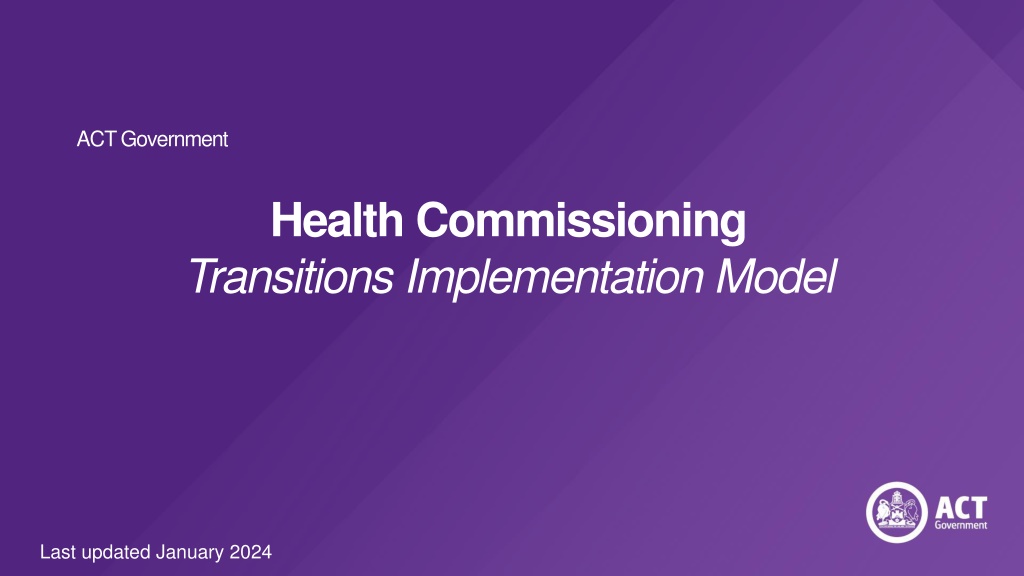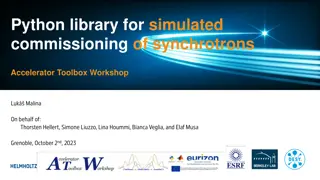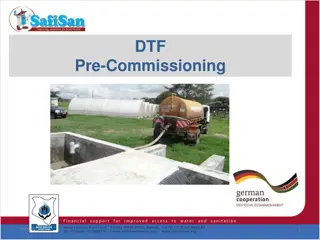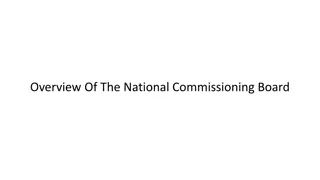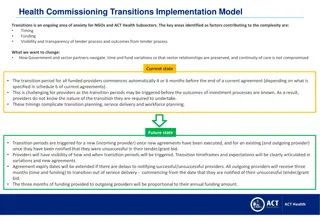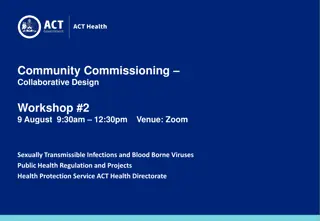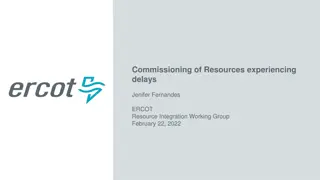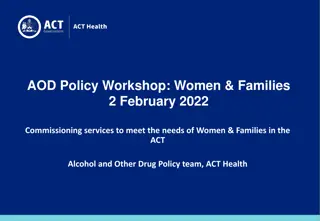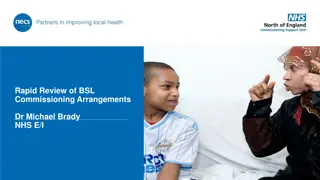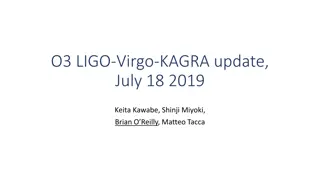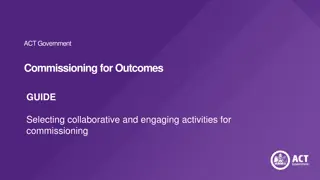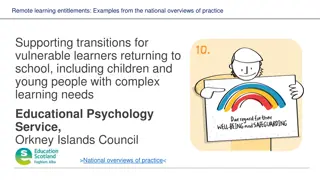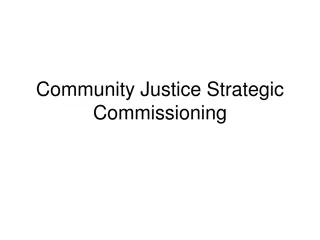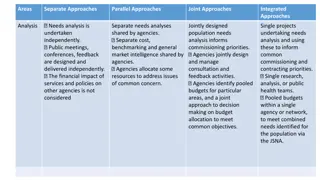Health Commissioning Transitions Implementation Model Overview
The Health Commissioning Transitions Implementation Model aims to streamline the transition process for service providers in the ACT government's health sector. The model outlines clear timelines, expectations, and procedures for both Preferred and Non-Preferred Respondents, ensuring a smooth and efficient transition between service providers. With a focus on transparent communication, flexible agreement expiry dates, and support for complex transitions, the model provides a structured approach to improving service delivery and workforce planning in the region.
Download Presentation

Please find below an Image/Link to download the presentation.
The content on the website is provided AS IS for your information and personal use only. It may not be sold, licensed, or shared on other websites without obtaining consent from the author. Download presentation by click this link. If you encounter any issues during the download, it is possible that the publisher has removed the file from their server.
E N D
Presentation Transcript
ACT Government Health Commissioning Transitions Implementation Model Last updated January 2024
Acknowledgement of Country We wish to acknowledge the Ngunnawal people as traditional custodians of the ACT, and recognise other people, families or groups with connections to the lands of the ACT and region. We respect and celebrate their continuing culture and the contribution they make to the life of this city and region.
Health Commissioning Transitions Current state Transition period commences automatically 4 or 6 months before the end of a current agreement Providers do not know the nature of the transition they are required to undertake and these timings complicate transition planning, service delivery and workforce planning. This is challenging for providers as the transition periods may be triggered before the outcomes of a tender/grant processes are known. Schedule 6 Future state The funding provided to Non-Preferred Respondents (outgoing providers) will be proportional to their annual funding amount. Transition periods are triggered once the Preferred and Non-Preferred Respondents have been notified of the outcome of the tender/grant process. Transition timeframes and expectations are clearly articulated in variations and new agreements. 3 months Agreement expiry dates are flexible and will be extended/reduced if there are delays to notifying preferred/non-providers providers, or if they are notified earlier. Additional time for more complex transitions may be sought on a case-by-case basis + All Non-Preferred Respondents (outgoing providers) will receive three months to transition out of service delivery
Health Commissioning Transitions Implementation Model BAU Service delivery Approach to Market Variations Notification Transition New service system in action. Preferred Respondents are notified of the Grant outcome and are invited to commence contract negotiations. New agreement terms are negotiated with Preferred Respondents and new agreements are signed and executed . Current agreements are varied to include new transition information/clauses relating to: Strategic Investment Plan is finalised, and Grant documents are developed and approved. Non-Preferred Respondents are notified that they have been unsuccessful in the grant process. Formal debrief is offered Grants go out to the sector via SmartyGrants platform. Non-Preferred Respondents are notified (this triggers the commencement of the transition-out period). New agreement expiry date Recovery of unspent funds Transition period length Expectations for transition preparedness Application period Sector briefing to be held within the first couple of weeks of application period. Overlap in service delivery between new/continuing providers (Successful Providers) and providers who are transitioning out (Unsuccessful Providers) Preferred and Non-Preferred Respondents may engage with one another and ACTHD to plan transition arrangements and clarify roles, responsibilities and expectations. Grants closes. Providers who are transitioning out will do so in accordance with contractual requirements and their Transitions Plans. Grant submissions are assessed Recommendations of Preferred and Non-Preferred Respondents are made to the Delegate for approval. Clients attached to outgoing providers will be transitioned to a new provider or out of service delivery if safe and appropriate. This flow diagram provides a snapshot of the end-to-end process of the model and how it will work in practice. *Service Providers are expected to develop a Transition Pan which considers a range of potential transitions scenarios. Transition Plans should be continually reviewed and updated throughout the Commissioning Cycle)
Transitioning from current providers to new providers Variation Approach to market Notification Transition (3 months) BAU service delivery Service delivery intensity for the outgoing provider is scaled back while the incoming provider ramps up their service delivery. Funding for outgoing and incoming providers will be adjusted to reflect these changes in service delivery intensity and available budget. Service delivery intensity BAU service delivery New provider/s 5 Flexible expiry date Ramp up service delivery 4 Current provider/s 1 2 3/4 Ramp down service delivery 2 1 3 Service delivery ceases Time 5 Incoming provider/s (Preferred Respondents) Current provider/s who are notified as a Non-Preferred Respondent, and will be transitioning out The current provider/s are funded to deliver services under the current agreement. Their current agreements will be varied to include new clauses relating to the return of unspent funds and the new transition period. New service Provider/s apply within open grant rounds. 1 1 Preferred Respondents are notified of the successful outcome of their grant application. 2 The current provider/s submit a SmartyGrants application within the grant round. 2 Non-Preferred Respondents will be notified of the outcome of the grant process. This triggers the commencement of the transition-out period. For transition periods that extend beyond current agreement expiry dates, transition-out funding will be provided to outgoing providers (Non-Preferred Respondents) as a proportion of their annual core funding for the extension period. The outgoing provider will engage with the incoming provider/s and ACTHD to commence the transition. The outgoing provider will ramp down service delivery over the course of the transition period, once new agreements with the incoming providers are in place. 5The outgoing provider ceases service delivery at the end of the transition period/expiry end date. Preferred Respondents commence preliminary transition engagement with outgoing providers (Non-Preferred Respondents) and ACTHD. 3/4 3 New agreement terms are negotiated with Preferred Respondents and new agreements are signed and executed. Transition activities progress. The incoming provider will ramp up their service delivery over the course of the transition period. 4 3/4 5 The incoming provider shifts to BAU service delivery. Notes: The funding available for service delivery within the subsector may be reduced for the first year of new agreements to coincide with a gradual ramping up of service delivery and so that funding can be redirected to cover transition-out periods. Funding will return to normal allocation for all providers in year 2 of agreements. The year-to-year funding breakdowns will be clearly articulated in new agreements. Any unspent funds recovered from providers will also support transition funding.
Transition flexible expiry dates Scenario - Early notification New clauses in agreements allow for an earlier expiry date if Non-Preferred Respondents are notified earlier than 3-months from the current agreement expiry date Notification of Non-Preferred Respondents triggers the commencement of the 3- month transition period 3-month transition period New earlier end date Scenario Notification occurs as scheduled Non-Preferred Respondents are notified 3 months prior to the current expiry date of the agreement, this triggers the commencement of the 3-month transition period. 3-month transition period Initial end date Scenario Delayed notification New clauses in agreements allow for a later expiry date if Non-Preferred Respondents are notified within 3 months from the current agreement expiry date - subject to parties agreeing to the new later expiry date. Notification of Non-Preferred Respondents triggers the commencement of the 3-month transition period 3-month transition period New later end date Notes: Whilst the Model articulates a 3-month standard transition period, additional time beyond the three months may be sought at a later date, on a case-by-case basis. Any attempts to extend transition periods before the grant assessment has been finalised may present a probity risk in terms of a pre-conceived perception of what the transition could look like, and the subsequent impacts of the perceived transition.
Transition planning What to consider The proposed timeline for transition of Services (standard timeframe is 3 months). How current resources (including staffing and financial resources) will be managed/reorientated to support the transition, whilst maintaining continuity of care and operations. Assessment of work product/activities/outputs which still needs to occur during the transition period (service/operational sustainability). Sub-contracting arrangements (and whether to transfer these to the incoming organisation). Identification of potential and/or actual risks, challenges and complexities which may arise as a result of the transition, and subsequent impacts on/in relation to clients and client care, workforce, assets, legal, financial, reputation, relationships etc. Consider mitigation strategies and actions which will need to be assigned. Number of current clients and how client care will be safely and practically transitioned between service providers- if required (e.g., through signed consent to transfer records forms, targeted communication or warm referral approaches etc). Details of assets held, contracts held and administrative arrangements relevant to the services, including but not limited to*: Technology and equipment used to provide the services/programs passwords and access details intellectual property held by the Organisation, in connection with the services/programs consumables used to provide the services/programs, and known suppliers legal, finance and other knowledge/skills used to provide the services/programs insurance arrangements communications protocols Notes: ACTHD will support transitioning providers in preparation for a transition and throughout the transition process. *Subject to legislation, policy, best practice approaches and contractual requirements
Thank you Should you require further information, please contact HealthCommissioning@act.gov.au
